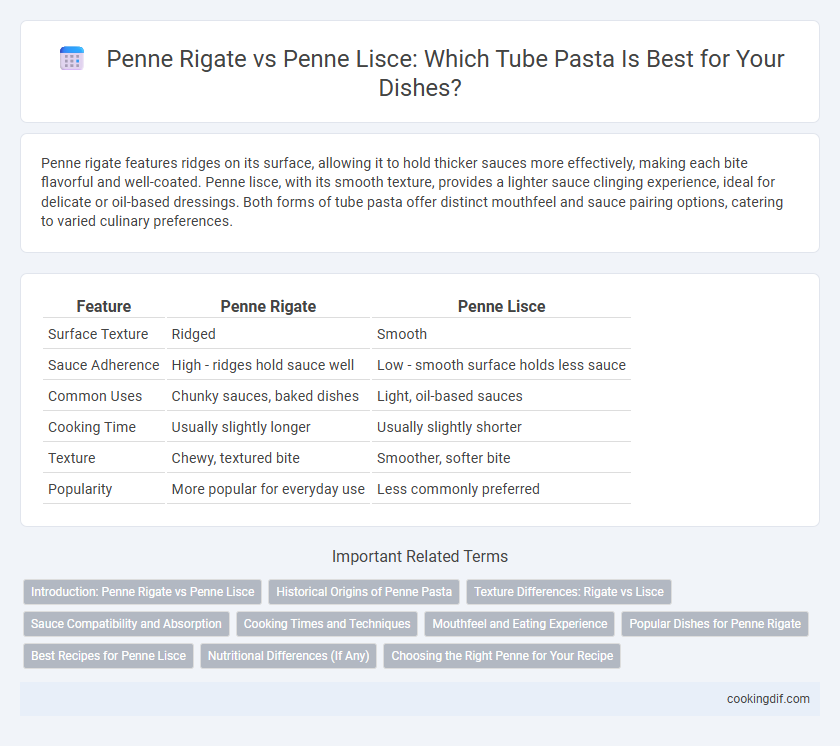Penne rigate features ridges on its surface, allowing it to hold thicker sauces more effectively, making each bite flavorful and well-coated. Penne lisce, with its smooth texture, provides a lighter sauce clinging experience, ideal for delicate or oil-based dressings. Both forms of tube pasta offer distinct mouthfeel and sauce pairing options, catering to varied culinary preferences.
Table of Comparison
| Feature | Penne Rigate | Penne Lisce |
|---|---|---|
| Surface Texture | Ridged | Smooth |
| Sauce Adherence | High - ridges hold sauce well | Low - smooth surface holds less sauce |
| Common Uses | Chunky sauces, baked dishes | Light, oil-based sauces |
| Cooking Time | Usually slightly longer | Usually slightly shorter |
| Texture | Chewy, textured bite | Smoother, softer bite |
| Popularity | More popular for everyday use | Less commonly preferred |
Introduction: Penne Rigate vs Penne Lisce
Penne rigate features ridged surfaces that enhance sauce adherence, making it ideal for thick or chunky sauces, while penne lisce offers a smooth texture suited for light, oil-based dressings. The tubular shape of both pasta types allows even cooking and excellent sauce capture inside the hollow center. Choosing between penne rigate and lisce depends on the desired texture and sauce pairing in the dish.
Historical Origins of Penne Pasta
Penne pasta originated in the Campania region of Italy during the 19th century, with the name "penne" inspired by the Italian word for "quills" or "pens" due to its tubular shape with angled ends. Penne rigate, featuring ridges on the surface, evolved to better hold sauces compared to the smooth-surfaced penne lisce, reflecting regional culinary preferences. The distinction between rigate and lisce highlights the historical adaptation of pasta textures to enhance sauce adherence and overall dining experience in traditional Italian cuisine.
Texture Differences: Rigate vs Lisce
Penne rigate features ridges on its surface that enhance sauce adhesion, providing a textured bite with more grip for thicker or chunky sauces. Penne lisce has a smooth surface that creates a silkier mouthfeel and allows lighter sauces to coat evenly without clinging excessively. The texture difference affects the overall eating experience, with rigate offering a heartier feel and lisce delivering a sleek, refined touch.
Sauce Compatibility and Absorption
Penne rigate, with its ridged surface, excels at capturing thick and chunky sauces, allowing for superior sauce absorption and flavor retention compared to penne lisce. The smooth exterior of penne lisce is better suited for lighter, oil-based sauces that coat rather than cling to the pasta. For dishes requiring robust sauce adherence, penne rigate enhances texture and taste by holding sauce in its grooves effectively.
Cooking Times and Techniques
Penne rigate features ridges that help sauce cling better, requiring slightly longer cooking times, typically around 11-13 minutes for al dente texture. Penne lisce, smooth-surfaced, cooks faster, usually in 9-11 minutes, and suits lighter sauces that don't need extra texture adhesion. Proper stirring and boiling techniques ensure even cooking for both, preventing sticking or overcooking.
Mouthfeel and Eating Experience
Penne rigate features ridged surfaces that enhance sauce adhesion and add a textured mouthfeel, creating a more dynamic eating experience compared to penne lisce's smooth exterior. The grooves on penne rigate provide extra grip for thick or chunky sauces, intensifying flavor with each bite, while penne lisce offers a softer, silkier sensation that suits lighter, creamier sauces. Texture interplay plays a crucial role in pasta preference, making penne rigate ideal for robust dishes and penne lisce preferable for delicate, subtle flavor profiles.
Popular Dishes for Penne Rigate
Penne rigate is preferred in popular dishes like penne alla vodka, baked ziti, and pasta salads due to its ridged surface that effectively holds sauces and enhances flavor absorption. The textured grooves of penne rigate trap chunky sauces, such as marinara or pesto, providing a balanced bite and rich taste experience. In contrast to penne lisce, which has a smooth surface and is better suited for lighter, oil-based sauces, penne rigate's versatility makes it a staple in hearty and robust Italian dishes.
Best Recipes for Penne Lisce
Penne lisce, characterized by its smooth surface, excels in recipes with light, creamy sauces such as Alfredo or delicate tomato-based dishes where sauce adherence is less critical. This variety complements seafood pasta recipes and fresh herb blends, allowing flavors to gently coat the pasta without overwhelming texture. While penne rigate's ridges trap chunkier sauces like arrabbiata or Bolognese, penne lisce is perfect for subtle, elegant dishes emphasizing smooth sauce consistency and refined presentation.
Nutritional Differences (If Any)
Penne rigate and penne lisce share nearly identical nutritional profiles, as both are made from similar ingredients like durum wheat semolina, providing comparable amounts of protein, carbohydrates, and calories. The primary difference lies in texture rather than nutrition, with rigate featuring ridges that help sauce cling better, while lisce has a smooth surface. Neither variation significantly alters nutrient absorption or glycemic index, making the choice more about culinary preference than health impact.
Choosing the Right Penne for Your Recipe
Penne rigate features ridges that hold onto sauces, making it ideal for thick, chunky, or creamy recipes where maximizing flavor adhesion is key. Penne lisce, with its smooth surface, works best in lighter sauces or baked dishes where a delicate texture is preferred. Choosing between penne rigate and lisce depends on the sauce consistency and the desired mouthfeel in your pasta dish.
Penne rigate vs penne lisce for tube pasta Infographic

 cookingdif.com
cookingdif.com